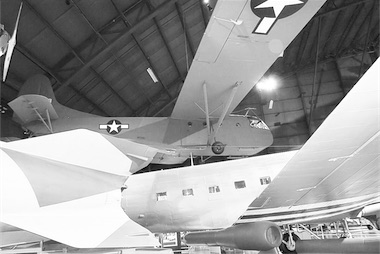Darlyle Watters of Jackson, Michigan, survived the shooting down of his plane in 1944 but spent eight months in a German prison camp. He later became a prominent World War II historian and played a major role in establishing a World War II air museum in Kalamazoo, Michigan. He was one of the first advanced tactical glider pilot instructors, and he coordinated the reconstruction of a WACO CG-4A glider that now is in the museum. He witnessed the death of Phillips on that fateful day. He and others called the WACO gliders “plywood coffins.”
This is his first-hand World War II story, as published in War Birds magazine in November, 1998, three years before he died at the age of 80:
“They say if you hear it, don’t worry about it it ain’t gonna get ya — the flak, that is. Well, I heard it and felt it too! Then there was that hollow gut feeling when I sensed wetness running down my neck and my back. Then there’s the gummy, sticky smell of blood trying to clot up to plug up your wounds. Scared the heck out of me! Too bad, too. It killed the lst lieutenant (Joe Phillips) in the copilot’s seat. He took 90 percent of the blast…he blocked me from getting hit worse, and though hurtin’, I was still in control of the glider.
WACO CG-4A glider on display. (Photo provided by Valder137/Flickr)
“This mission should have been aborted long ago. It was Operation Market Garden – the invasion of Holland – made famous in Cornelius Ryan’s book, A Bridge Too Far. Well, I never got near that bridge or any other bridge. The weather was bad when we started out from England, and it steadily got worse. Even though we were not supposed to fly missions ‘on instruments,’ we had to on this one. Even being towed behind a tug. We had flown across the North Sea and were into Belgium, fighting the fog and rain all the way. I was so tired I couldn’t even spit! We were at about the Belgium-Holland border when the flak started to open up. I was wide awake then!
“When you only have some steel tubing, a bit of wood, and a sheet of fabric between you and all that flying metal, you grab that wheel like it was your best girl. I called my ship Jeannie II, named after my wife. In the back of the WACO were a dozen souls scared to death. In fact, some were close to death, having been wounded by the shrapnel flung from the 88s. I had no co-pilot, there were not enough pilots to go around. There was just the lieutenant, and now he was dead.
“The scud (flak) was absolutely terrible. The C-47 towing me was sure taking a beating. Then the tow rope went slack, and the damaged C-47 banked away, still drawing fire. But now the Jerries had a sitting duck, a motorless glider, laden with troops and going all of about 120 miles an hour. The flak bursts started to concentrate around me. In training, I taught others how to do a loop and I almost did one here. I turned left, cut to the right, then left, did partial dips. I did anything I could to make sure the flak batteries couldn’t draw a bead. Though twistin’ and turnin,’ I was able to spy a drainage ditch along the fields below, good cover, if I could land near it. I wrung that baby around and skidded her right alongside that ditch. The guys from the 101st jumped right out and I soon followed as my wounds were superficial. I wanted to go get the flak guns that got us, but the sergeant in charge of the troops had rank, so we headed for allied lines back the way we came. Well, we made it about 200 yards and were surrounded. Hell, they were just 18-year-old kids, German paratroopers. They were so far from the fighting they didn’t even have helmets, just soft hats.
But for me…’ze war wus over.”
— Arranged by Dwight Esau





